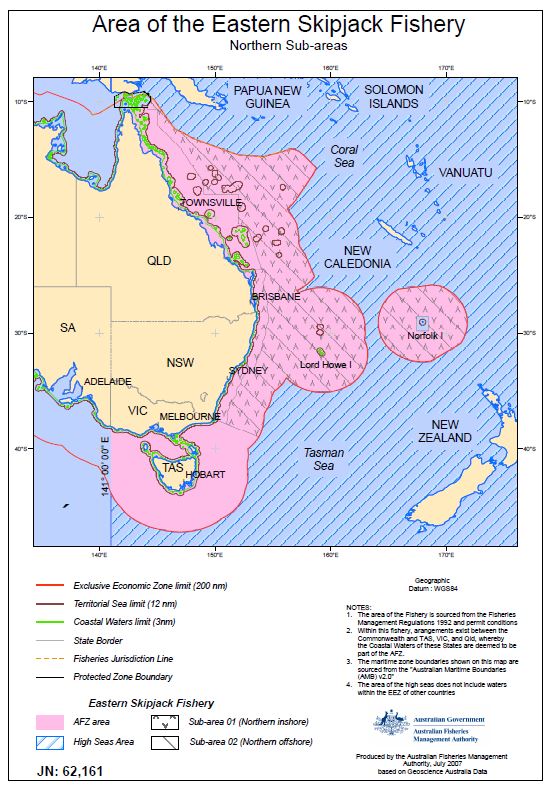Tuna has a mild, meaty flavour. The meat is bright red when raw and turns brown-grey when cooked.
Skipjack tuna is most commonly canned.
Scientific name: Katsuwonus pelamis
Family: Scombridae
Other names: Striped tuna, oceanic bonito
Description: Skipjack tuna have torpedo-shaped bodies with dark blue or purple backs, and silver on the lower sides and belly. They have 3-5 prominent dark bands running along the length of the lower sides. Skipjack tuna are mostly scaleless.
Size (length and weight): Up to 1.1 metres in length and 34.5 kg.
Life span: About 8‑12 years.
Habitat: Skipjack tuna are widespread throughout the tropical waters of the Pacific, Atlantic and Indian Oceans. Skipjack tuna are highly migratory and travel long distances. They are a pelagic species that can be found to depths of 260 metres. Skipjack tuna tend to school by size. Schools are often associated with albacore or yellowfin tuna, and sometimes with whales or whale sharks. Schools may also occur in association with floating objects. Juveniles are generally found in surface waters and move into deeper water as they mature.
Prey: Crustaceans, fish and squid. Cannibalism is common in larger individuals.
Predators: Larger fish such as yellowfin and bigeye tunas, and billfish.
Reproduction: Skipjack tuna reach reproductive maturity at 1‑2 years of age. They spawn throughout the year in tropical waters, and during summer and early autumn in subtropical waters. In tropical waters females spawn almost daily. Females produce 0.8‑2 million eggs per spawning season depending on their body size. Eggs hatch after 1‑1.5 days.
| Fishery found in | Gear used | Catch of this species is targeted or incidental |
|---|---|---|
| Eastern Skipjack Tuna Fishery | Purse seine and pole & line | Targeted |
| Western Skipjack Tuna Fishery | Purse seine and pole & line | Targeted |
| Eastern Tuna and Billfish Fishery | Pelagic longline and pole and line | Incidental |
| Western Tuna and Billfish Fishery | Pelagic longline | Incidental |
| Recreational and other countries | Various | Targeted and incidental |
In the skipjack tuna fishery there are a number of management measures to ensure that skipjack tuna is sustainable. Those measures are:
- limited entry
- fishing gear restrictions
- operations limited to fishing zones specified on permits
- trip limits for bycatch species
- mandatory logbooks
Skipjack tuna is a highly migratory species and is caught by many other countries. The Western and Central Pacific Fisheries Commission and the Indian Ocean Tuna Commission are responsible for managing the international catch of skipjack tuna. Australia is a leading member of both these Commissions and AFMA has to follow the decisions made by both commissions when managing the Australian skipjack tuna catch.
Skipjack tuna is caught throughout the tropical waters of the Pacific and Indian Oceans. The distribution of skipjack tuna in Australia is from far north Queensland to Tasmania, around southern Australia and and up the coast of Western Australia to Broome.
The skipjack tuna fishery is split into east and west:
- The Eastern Skipjack Tuna Fishery extends from Cape York Peninsula to the South Australian/Victorian border.
- The Western Skipjack Tuna Fishery extends westward from the South Australian/Victorian border across the Great Australian Bight and around the west coast of Western Australia to the Cape York Peninsula.
Skipjack tuna is also sometimes caught recreationally off Queensland, New South Wales and Victoria. Recreational catches are managed by the state governments.

Fishers use purse seine nets and sometimes pole and line when fishing for skipjack tuna.
The purse seine method of fishing is very selective as it usually targets only one species at a time. This means that there is very little impact from purse seine fishing on other marine species. Purse seine nets are set near the ocean surface and do not touch the sea floor, so their impact on the marine environment is also very small.
In some countries, purse seine nets may be set around a floating object such as ocean debris. These objects are called Fish Aggregating Devices (FADs) and large numbers of fish are often attracted to these. This means that if a purse seine net is set around a FAD, many other marine species may be caught. The use of FADs for purse seine fishing is not allowed in Australia.
Pole and line fishing is another selective form of fishing that catches only the species it is targeting. As it is a surface gear, it does not impact on the seafloor and other marine species are very rarely caught.
Ecological risk assessments are done to find out if the fishing of skipjack tuna is harming other species. The most recent assessment was done in 2009 and the risk to other species was assessed as low.
Gear
Want to know more?
This is just an overview of skipjack tuna, if you want to know more see the links below.
This fish is managed under the Skipjack Tuna Fishery.